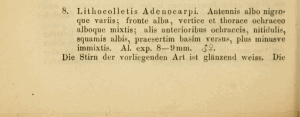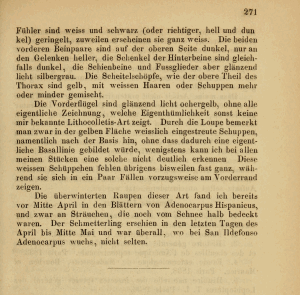Länder:

 +1Kontinente:EU
+1Kontinente:EU


 +1Kontinente:EU
+1Kontinente:EUNeues Layout der Navigation (Beta Test)
LebendfotosFalterDiagnoseBiologieNahrung der RaupeWeitere InformationenEtymologie (Namenserklärung)Andere KombinationenFaunistikLiteraturInformationen auf anderen Websites (externe Links)
2. Diagnose
2.1. Erstbeschreibung
1-2: Staudinger (1863: 270-271) [nach Copyright-freien Scans auf www.biodiversitylibrary.org]
3. Biologie
3.1. Nahrung der Raupe
- [Fabaceae:] Adenocarpus hispanicus [= Cytisus hispanicus, Cytisus anagyrius] (Spanischer Drüsenginster)
Die Erstbeschreibung erfolgte auf der Basis von Raupenfunden an Adenocarpus hispanicus.
4. Weitere Informationen
4.1. Etymologie (Namenserklärung)
Die Art wurde nach der Nahrungspflanze ihrer Raupe - Adenocarpus hispanicus - benannt.
4.2. Andere Kombinationen
- Lithocolletis adenocarpi Staudinger, 1863 [Originalkombination]
4.3. Faunistik
Locus typicus ist San Ildefonso (= La Granja) in Zentralspanien. Der Falter ist - wie seine Raupennahrungspflanze Adenocarpus hispanicus - auf Teile von Spanien und Portugal beschränkt.
Corley (2015) schließt die Art mit Anmerkung 0278A aus der Fauna Portugals aus: "ALG: Monchique 19.v.1880 Eaton (Stainton, 1881). Specimen in BMNH is Tischeria ekebladella (Corley & Goodey, 2014). There are no subsequent records."
4.4. Literatur
- Corley M.F.V. (2015): Lepidoptera of Continental Portugal. A fully revised list. Martin Corley, Faringdon. 288pp.
- Corley, M.F.V. & B. Goodey (2014): A re-examination of the Portuguese Microlepidoptera collected by the Reverend A. E. Eaton in 1880. — Entomologist’s Gazette 65: 15-25.
- Erstbeschreibung: Staudinger, O. (1863): Einige neue europäische Lepidopteren. — Entomologische Zeitung 24 (7-9): 264-271. Stettin.





